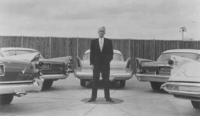Chrysler Look Forward
A complete new line of Chrysler Corporation cars, including Plymouth, Dodge, DeSoto, Chrysler and Imperial, were designed by Virgil Exner (see below), along with Henry T. King, H.T. Bannister, Clifford C. Ross, Carl Reynolds and Robert E. Bingham. It was called the "Forward Look," Chrysler's entry into a race with General Motors to see who can build the biggest tail fins. The "Forward Look" was a big hit.
Virgil Max Exner (1909-1973) was a US automotive designer, born in Ann Arbor, MI. He studied art at Notre Dame and started as advertising artist at an agency handling the Studebaker account. He was hired by Harley Earl at General Motors in 1933 and became styling chief for Pontiac, where he designed the famous "Silver Streak" hood ornament. In 1937 he went to the office of Raymond Loewy, and in 1939 was assigned by Loewy to head the Studebaker account in South Bend, with the major role in design of the postwar Studebaker (introduced in 1947). But in 1944, he was fired by Loewy and hired directly by Studebaker. In 1948 Exner returned to Detroit to work for Chrysler, was named Director of Styling in 1953 and developed their "Forward Look." He became VP of Chrysler in 1957 and served in that capacity until 1961.
Why did cars have useless tail fins? Well, fifteen years earlier, in 1942, Lockheed's new P-38 Lightning fighter plane entered service in WWII. It was designed by Clarence "Kelly" Johnson and had three fuselages: the middle with a cockpit and pilot, and a right and left fuselage, each with an engine and individual tail fin. It was a unique and dramatic design for fighter planes, recognized instantly around the world.
In about 1947, Harley Earl, head of GM styling since 1927, was inspired by the P-38's tail-fins, and incorporated similar dual fins on an experimental concept convertible which would in 1951 be publicly exhibited and called "Le Sabre". It sported a "jet" intake and the first true, curved, wrap-around windshield, under development by Libbey-Owens-Ford since 1946. The LeSabre design was worked on by Homer LaGassey and named after the North American F-86 Sabre fighter jet just put into service in the Korean War. The design set GM styling trends for many years. Curved windshields appeared on 1954 production models of Cadillac, Buick, and Oldsmobile. The name "LeSabre" was adopted by Buick in 1961 and was still in use in 1995, with jet intake still evident.
However, Earl was so enthralled with the twin fin concept on the "LeSabre" drawing boards, that he decided to put smaller versions of the fins on the 1948 Cadillac, about to be finalized for production.
In 1951, of course, General Motors publicly exhibited the "LeSabre" with great fanfare, and the concept of car fins was catapulted to the front pages of the automotive world. By the mid-1950s, Most GM cars had fins, and Chrysler was pretty much forced to follow the popular trend.
General Motors retaliated to Chrysler's 1947 Forward Look" challenge in 1959, Harley Earl's last year at GM, when tail fins reached their apogee on the 1959 Cadillac. After Earl's retirement, his successor, William Mitchell, quietly began scaling them back, and they never returned to the market. But with the "retro" design trend of the "oughties, we may see them again!"
